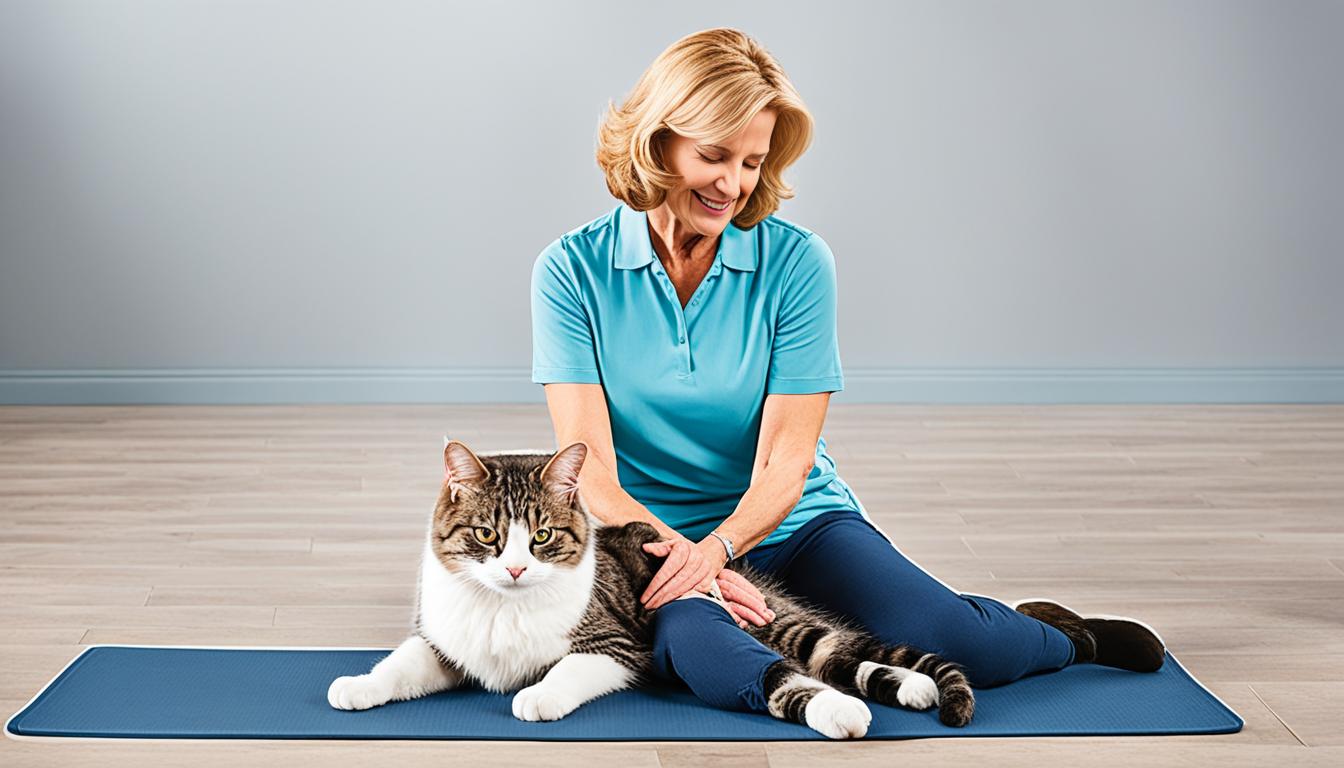How to Pick Up a Cat Safely and Properly
Learn how to pick up a cat with ease. Our guide ensures you handle your feline friend safely and comfortably every time.

Picking up a cat may seem like a simple task, but it’s crucial to approach it with caution and proper technique. Did you know that an estimated 1.4 million cat-related injuries occur in the United States each year? That’s why it’s essential to learn how to pick up a cat safely, ensuring the well-being of both you and your furry friend. We will guide you through the proper techniques and safety measures to pick up a cat safely and comfortably. Whether you’re a new cat owner or looking to improve your handling skills, these tips will help you establish a trusting and secure bond with your feline companion.
Understanding Your Cat’s Preferences and Boundaries
Before attempting to pick up a cat, it is important to understand their preferences and boundaries. Cats are unique individuals with distinct likes and dislikes. By understanding their preferences, you can create a more comfortable and positive environment for both you and your feline friend.
One key aspect of understanding your cat’s preferences is recognizing their behavioral cues. Cats communicate through their body language, facial expressions, and vocalizations. Take the time to observe your cat and learn what different behaviors mean. For example, a relaxed and content cat may exhibit a slow blinking or a relaxed body posture. On the other hand, a cat that is agitated or fearful may display dilated pupils and a tense body posture. Recognizing these cues will help you gauge your cat’s comfort level and adjust your interactions accordingly.
Respecting Your Cat’s Personal Space
Cats are naturally independent and value their personal space. It is crucial to respect their boundaries and understand when they need some alone time. Avoid forcing physical contact or crowding your cat when they show signs of wanting space. Give them the option to approach you on their terms and provide them with cozy hiding spots where they can retreat when they need privacy. By respecting their personal space, you will build trust with your cat and create a more harmonious relationship.

Building Trust Before Handling
Building trust with your cat is essential before attempting to handle them. Trust is earned through positive experiences and interactions. Spend time engaging in activities your cat enjoys, such as playing with interactive toys or offering treats during play sessions. Create a peaceful and secure environment for your cat where they feel safe. By building trust, your cat will become more comfortable and relaxed in your presence, making it easier to handle them when necessary.
Why Is Picking Up a Cat So Hard?
Picking up a cat can be quite a challenge, even for experienced cat owners. There are several reasons why it can be difficult to pick up a cat, especially if they are independent or have had negative experiences in the past.
Cats are naturally independent and have a strong sense of personal space. They value their freedom and may not always welcome being picked up or restrained. This instinctual behavior can make it harder for you to approach and handle them. Additionally, cats are known for their sensitive nature. They may have had negative experiences with being picked up in the past, such as being mishandled or dropped. These experiences can create fear or anxiety around being lifted off the ground, causing cats to resist being picked up.
Understanding these instinctual behaviors and apprehensions is crucial in order to make the process of picking up a cat easier and less stressful for both of you. With patience, trust-building, and the proper techniques, you can overcome the challenges and ensure a positive experience for your feline companion.

- Approaching the cat calmly and slowly
- Allowing the cat to approach you first
- Gaining their trust through positive interactions, such as offering treats or engaging in play
- Using gentle and supportive hand positioning when lifting
By understanding the challenges and taking the necessary precautions, you can successfully pick up a cat without causing stress or discomfort. The key is to approach the process with patience, empathy, and respect for your cat’s boundaries.
Approaching Your Cat with Care and Patience
Approaching a cat requires a delicate balance of care and patience to establish a positive connection. Cats are known for their independent nature and may have unique preferences when it comes to interactions with humans. By understanding the right approach and employing non-threatening movements, you can build trust and ensure a harmonious relationship with your feline companion.
When and How to Approach Your Cat
Choosing the right time to approach your cat is essential for a successful interaction. Cats are creatures of habit and appreciate routine, so it’s best to approach them when they are calm and relaxed. Avoid disturbing them during their rest or nap time, as this may startle or agitate them.
When approaching your cat, make sure to use slow and deliberate movements to avoid startling them. Quick or sudden movements can trigger a fear response, causing the cat to become defensive or retreat. Begin by observing your cat’s body language to determine if they are open to interaction.
If your cat shows signs of relaxation, such as a relaxed body posture, slow blinks, or a softly flicking tail, it may indicate that they are receptive to attention. In contrast, signs of tension or aggression, such as flattened ears, a puffed-up tail, or hissing, indicate that the cat is not in the mood for interaction and should be given space.
The Importance of Calm and Non-Threatening Movements
Cats are sensitive to even the slightest threatening movements, so it’s crucial to maintain a calm demeanor when approaching them. Avoid making sudden gestures, reaching directly towards the cat, or hovering over them, as this can be perceived as a threat.
Instead, use gentle and non-threatening movements to gain your cat’s trust. Extend your hand slowly and allow them to smell your fingers before making any physical contact. This gesture allows the cat to become familiar with your scent, helping to establish a sense of comfort and security.
Additionally, avoid making direct eye contact during the initial approach as this can be perceived as a challenge. Instead, avert your gaze slightly to show respect and non-aggression towards the cat. By keeping calm and using non-threatening movements, you create an environment of trust and safety, paving the way for a positive interaction.

| Potential Approaches | Effect on the Cat |
|---|---|
| Slowly extending a hand for the cat to sniff | Allows the cat to feel secure and familiarize themselves with your scent |
| Making sudden or aggressive movements | Causes the cat to become fearful or defensive |
| Maintaining a calm and relaxed posture | Helps the cat feel at ease and comfortable |
| Avoiding direct eye contact | Shows respect and non-aggression towards the cat |
How to Pick Up a Cat Who Doesn’t Want to Be Picked Up?
Some cats can be quite stubborn when it comes to being picked up. They may resist due to fear, discomfort, or simply because they prefer to be on the ground. However, there are ways to safely handle a reluctant cat and ensure their well-being.
When attempting to pick up a cat who doesn’t want to be picked up, it’s important to approach the situation with patience and understanding. Forcing a cat to be held against their will can lead to stress and potential injuries, both for the cat and for you.
To successfully handle a cat that doesn’t want to be picked up, consider the following tips and techniques:
- Give the cat plenty of space and avoid hovering over them. Allow them to approach you on their terms.
- Reward the cat with treats or praise when they display calm behavior or approach you willingly.
- Spend time bonding with the cat through play and gentle interactions. Let them get accustomed to your presence and touch.
- Ensure that the cat feels secure in their surroundings. Provide hiding spots and vertical spaces where they can retreat if they feel overwhelmed.
- Speak softly, move slowly, and avoid sudden movements that could startle the cat. This will help them feel more at ease around you.
Remember, each cat is unique, and it may take time for them to feel comfortable being picked up. Be patient and understanding, and always prioritize the cat’s well-being and comfort.

| Technique | Description |
|---|---|
| 1. The Scruff Hold | This technique involves firmly but gently holding the loose skin at the back of the cat’s neck. It mimics the way a mother cat would carry her kittens. However, this hold should only be used for short durations and with caution, as some cats may find it uncomfortable or distressing. |
| 2. The Underarm Hold | Support the cat’s body with one arm while cradling their hindquarters with the other. This technique provides stability and comfort for the cat, as well as minimizing the risk of injury. |
| 3. The Burrito Wrap | Wrap the cat securely but gently in a blanket or towel, leaving their head exposed. This technique can help soothe and calm anxious cats, making them feel safe and secure. |
How to Pick Up a Cat Safely: A Step-by-Step Guide
Picking up a cat may seem like a simple task, but it’s important to do it safely and properly to ensure the comfort and security of the cat. We will provide you with tips on how to pick up a cat in a way that is secure and comfortable for both you and the cat.
Positioning Your Hands for Support
Before attempting to lift a cat, it’s crucial to position your hands properly to provide adequate support. Start by standing beside the cat and gently place one hand under its chest, right behind the front legs. This hand will bear most of the cat’s weight. With your other hand, support the cat’s hindquarters by placing it under the back legs.
It’s important to note that cats have a natural desire for stability and may feel insecure if their hind legs are left dangling. By supporting their hindquarters, you create a sense of security and prevent any discomfort.
How to Ensure a Secure and Comfortable Lift
Once you have positioned your hands correctly, use gentle and controlled movements to lift the cat. Avoid any sudden or jerky motions that could startle the cat. As you lift the cat, be mindful of its body position and maintain a secure grip. Keep the cat close to your body to provide a sense of safety and stability. Avoid holding the cat too far away or at an awkward angle, as this can make both you and the cat feel unbalanced. Remember to always support the cat’s weight with your hands and avoid gripping it tightly. Cats are sensitive creatures, and it’s important to ensure their comfort and well-being during the lifting process.
How Do Cats Like to Be Picked Up?
Cats have their own preferences when it comes to being picked up. To ensure a positive and comfortable experience for your feline friend, it’s important to understand the different comfort holds that cats often enjoy and feel secure in. One common comfort hold is the “cradle hold.” This involves positioning one hand under the cat’s chest and the other hand supporting their hindquarters. This hold mimics the support that a mother cat would provide to her kittens, creating a sense of safety and security.
Another comfort hold is the “shoulder hold.” With this hold, you gently lift the cat and position them on your shoulder, with one hand supporting their backside. Cats often enjoy this hold as it allows them to be close to your face, providing comfort and a sense of familiarity. Some cats also prefer the “lap hold.” This involves gently placing the cat on your lap and providing support with both hands. This hold allows the cat to feel grounded and secure while being in a relaxed and comfortable position.
| Comfort Hold | Description |
|---|---|
| Cradle Hold | Position one hand under the cat’s chest and the other hand supporting their hindquarters. |
| Shoulder Hold | Gently lift the cat and position them on your shoulder while supporting their backside. |
| Lap Hold | Place the cat on your lap and provide support with both hands for a relaxed and secure position. |
It’s important to remember that not all cats have the same preferences, so it’s essential to observe your cat’s body language and cues to determine which comfort hold they prefer. Some cats may also have physical limitations or medical conditions that require specific handling techniques, so it’s always a good idea to consult with your veterinarian for guidance.
By understanding and using comfort holds when picking up your cat, you can create a positive and enjoyable experience for both you and your feline companion.
Is There a Bad Way to Pick Up a Cat?
While picking up a cat can be a simple and common action, it’s important to be aware of the common mistakes and bad practices that can lead to discomfort or even harm for our feline friends. By understanding and avoiding these mistakes, we can ensure a safer and more enjoyable experience for both us and our cats. When it comes to picking up a cat, there are several common mistakes that pet owners should be aware of:
- Picking up the cat by the scruff of the neck (for adult cats)
- Using excessive force or gripping the cat too tightly
- Grabbing the cat from above or approaching too quickly
- Ignoring the cat’s body language or discomfort cues
By avoiding these mistakes, we can prevent unnecessary stress and potential injuries to our cats.
Why Scruffing is Not Recommended for Adult Cats
Scruffing, the practice of lifting a cat by the loose skin on the back of their neck, is commonly used with kittens but is not recommended for adult cats. While it may seem like a convenient way to control a cat’s movement or prevent scratching, scruffing can actually be painful and distressing for adult cats.
Scruffing can cause discomfort and even injury to the cat, as the skin on the neck becomes less loose and elastic as they grow older. Additionally, scruffing can lead to a loss of trust between the cat and their caregiver, making future handling and interactions more challenging. Instead of scruffing, it is recommended to use gentle and supportive handling techniques when lifting adult cats. This involves placing one hand under the cat’s chest or supporting their hindquarters, providing them with a sense of security and stability during the lift.
How Do You Pick Up a Cat Without It Hurting?
Lifting a cat without causing any discomfort or pain is essential for their well-being. Cats are delicate creatures, and handling them improperly can lead to anxiety, fear, and even physical injury. To ensure a safe and comfortable lift, follow these techniques and tips:
- Cats have their own moods and preferences. Choose a time when your cat is calm and relaxed to minimize stress.
- Move slowly and quietly towards your cat, avoiding sudden movements that may startle them. Let them sniff your hand to establish trust.
- Place one hand under your cat’s chest behind the front legs. Support the hind legs with your other hand. This technique provides stability and reassurance.
- Use a smooth upward motion to lift your cat. Avoid applying too much pressure or squeezing tightly, as it may cause discomfort.
- Once lifted, cradle your cat close to your body to provide a sense of security. Maintain a gentle and supportive grip.
- Throughout the process, speak softly and offer reassurance. Pay attention to their body language and adjust your handling accordingly.
By using these techniques, you can pick up your cat without causing any pain or discomfort. Remember, every cat is unique, so be patient and observant of their individual preferences and needs. If you are unsure about lifting your cat or if your cat shows signs of distress or discomfort during lifting, it’s important to consult with a veterinarian or a professional cat behaviorist for guidance.
FAQs on how to pick up a cat
How do you pick up a cat who doesn’t want to be picked up?
If a cat doesn’t want to be picked up, it’s important to respect their boundaries. Instead of forcing them, try using positive reinforcement to build trust and gradually introduce the idea of being picked up. You can also use treats or toys to distract them while you carefully lift them.
How do you pick up a cat without it hurting?
To pick up a cat without causing discomfort, it’s important to support their entire body and avoid putting pressure on their sensitive areas like the belly or legs. Use both hands to provide a secure and gentle lift, making sure to avoid any sudden movements or jerks.
How do cats like to be picked up?
Cats are individuals with unique preferences, but many cats feel secure when they are picked up with a “cradle hold” or in a “football hold.” These holds provide support to their body while keeping their paws free and giving them a sense of security.
Is there a bad way to pick up a cat?
Yes, there are several bad practices when picking up a cat. Scruffing, especially in adult cats, can cause pain and discomfort. Other bad practices include lifting a cat by its tail or only gripping its front legs. It’s important to avoid any actions that could harm or distress the cat.







